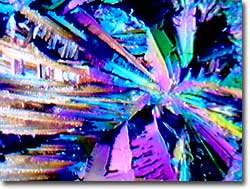Chemical Crystal Movie Gallery
Laetrile Time Lapse Sequence
Originally marketed during the 1920s by the famous biochemist Forest T. Krebs, Laetrile is a very controversial treatment for cancer. Known to biochemists as amygdalin, Forest and his son Ernest named the compound vitamin B-17, even though metabolic needs and vitamin deficiencies when excluded from the human diet have never been demonstrated.

Banned by the U.S. Food and Drug Administration, many cancer patients from the U.S. still travel to Mexico for Laetrile treatments. While the antitumor and anticancer properties of this carbohydrate have not been proven, some research has shown that ingesting excessive amounts of amygdalin may even be lethal. Named by the younger Krebs in 1949, the term Laetrile is a patented acronym for laevorotatory mandelonitrile, the purified form of amygdalin, or l-mandelonitrile-B-glucuronic acid. It is a six-carbon benzaldehyde ring compound with a cyanide group and two attached glucose molecules with a molecular weight of 457.4 and incorporates 20 carbon, 27 hydrogen, 1 nitrogen, and 11 oxygen atoms per molecule. As a white, odorless powder, the melting range of 210 to 218 degrees Celsius varies with the water of crystallization and previous melting. Laetrile is soluble in water and ethanol, but not in ether. In a saturated aqueous solution, the pH is neutral at 7.0.
Amygdalin is found naturally in the seeds and pits of apples, cherries, peaches, plums, almonds, papaya, nectarines, and apricots. It also occurs in raw nuts, lima beans, clover, and sorghum. In plants, the cyanogenetic diglucoside may play a natural role in fruit ripening and as a fungicide. Amygdalin was first isolated in 1830 by the French biochemists Pierre-Jean Robiquet and Antoine Franšois Boutron-Chalard, was dubbed "emulsin" by Liebigand W÷hler in 1837, and used as early as 1845 in Russia as an anticancer agent. During the 1920s, Forest Krebs isolated the plant compound from apricot pits and sang its praise for fighting cancer. A synthesized, less toxic form was patented by the Krebs father and son team in the 1950s in the United States as Laetrile, and it gained popularity as a cancer treatment in the 1970s. Side effects of Laetrile treatments are similar to those of cyanide poisoning. Symptoms include headaches, dizziness, bluish skin due to low blood oxygen, liver damage, and even death. Laetrile's side effects are accentuated by eating raw almonds, fruit pits, certain vegetables and fruits (celery, peaches, bean sprouts, and carrots), or by taking high doses of vitamin C.
Laetrile Time Lapse Sequence #1 - In this 9-image time-lapse sequence acquired utilizing polarized light, crystallization occurs from a melt phase and advances across the viewfield from right to left.
Contributing Authors
Omar Alvarado, Thomas J. Fellers and Michael W. Davidson - National High Magnetic Field Laboratory, 1800 East Paul Dirac Dr., The Florida State University, Tallahassee, Florida, 32310.
BACK TO THE CHEMICAL CRYSTAL MOVIE GALLERY
BACK TO THE DIGITAL IMAGE GALLERIES
Questions or comments? Send us an email.
© 1995-2025 by Michael W. Davidson and The Florida State University. All Rights Reserved. No images, graphics, software, scripts, or applets may be reproduced or used in any manner without permission from the copyright holders. Use of this website means you agree to all of the Legal Terms and Conditions set forth by the owners.
This website is maintained by our
Graphics & Web Programming Team
in collaboration with Optical Microscopy at the
National High Magnetic Field Laboratory.
Last Modification Friday, Nov 13, 2015 at 01:19 PM
Access Count Since September 17, 2002: 18811
Visit the website of our partner in introductory microscopy education:
|
|
